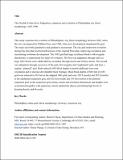| dc.contributor.author | Ryan, Brent D. | |
| dc.contributor.author | Wang, Elaine | |
| dc.date.accessioned | 2024-11-15T21:32:07Z | |
| dc.date.available | 2024-11-15T21:32:07Z | |
| dc.date.issued | 2023 | |
| dc.identifier.uri | https://hdl.handle.net/1721.1/157552 | |
| dc.description.abstract | his study examines the evolution of Philadelphia’s city block morphology between 1683, when the city was planned by William Penn, and 1900, when urban expansion abandoned the grid. The study uses both quantitative and qualitative assessment. The city grid underwent evolution during this time that resolved deficiencies of the original Penn plan, improving circulation and maximizing block area for rowhouse development. The Penn grid had large rectilinear blocks with irregular dimensions: it experienced two types of evolution. The first was adaptation through infill, as large 1683 blocks were subdivided by secondary through streets and tertiary streets. The second was adaptation through expansion of the grid, first an irregular, ‘unplanned’ grid, and later a regular, ‘planned’ grid. Both expansions reduced 1683 block depths to permit additional east- west circulation and to increase developable block frontage. Mean block depths of 666 ft in the Penn grid were reduced to 383 ft in the adapted grid, to 328 ft (south) and 393 ft (north) in the unplanned expansion grid, and to 422 ft (south) and 534 ft (north) in the planned expansion grid. In the expansion grid, tertiary streets and rowhouse dimensions and heights were integrated with quaternary streets (pedestrian alleys), permitting high levels of housing density and diversity. | en_US |
| dc.language.iso | en_US | |
| dc.publisher | International Seminar on Urban Form | en_US |
| dc.relation.isversionof | https://doi.org/10.51347/UM27.0001 | en_US |
| dc.rights | Creative Commons Attribution-Noncommercial-ShareAlike | en_US |
| dc.rights.uri | http://creativecommons.org/licenses/by-nc-sa/4.0/ | en_US |
| dc.title | The flexible urban grid: adaptation, expansion and evolution in Philadelphia's city block morphology | en_US |
| dc.type | Article | en_US |
| dc.identifier.citation | Ryan, B., & Wang, E. (2023). The flexible urban grid: adaptation, expansion and evolution in Philadelphia’s city block morphology. Urban Morphology, 27(1), 3–30. | en_US |
| dc.contributor.department | Massachusetts Institute of Technology. Department of Urban Studies and Planning | en_US |
| dc.relation.journal | Urban Morphology | en_US |
| dc.eprint.version | Author's final manuscript | en_US |
| dc.type.uri | http://purl.org/eprint/type/JournalArticle | en_US |
| eprint.status | http://purl.org/eprint/status/PeerReviewed | en_US |
| dspace.date.submission | 2024-11-15T20:34:58Z | |
| mit.journal.volume | 27 | en_US |
| mit.journal.issue | 1 | en_US |
| mit.license | OPEN_ACCESS_POLICY | |
| mit.metadata.status | Authority Work and Publication Information Needed | en_US |
